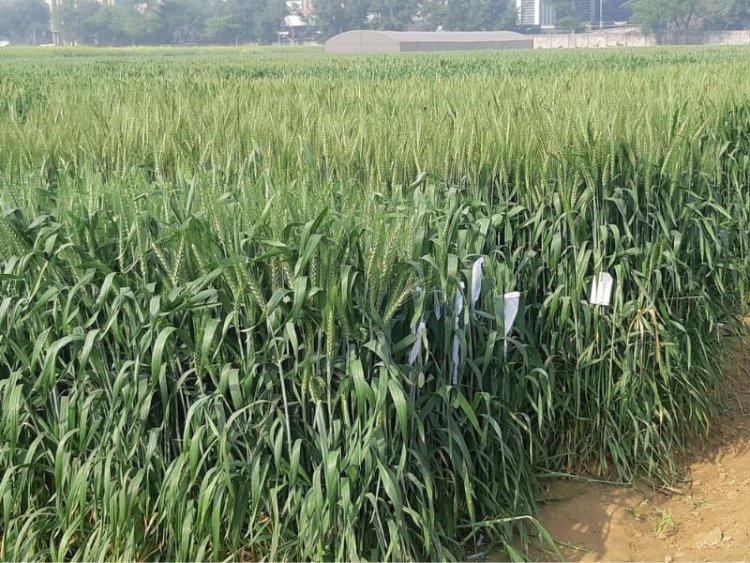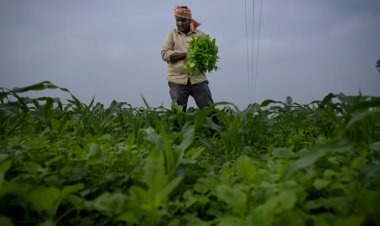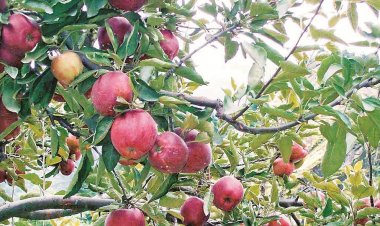Wheat production likely to hit record: Global, domestic prices fall - good for govt, not farmers
Looking at the conditions so far, it seems that wheat crop is moving towards better production this year. Last year, a sudden rise in temperature from the third week of March caused heavy damage to the wheat crop. This year too, there was a possibility of production getting affected due to higher than normal temperature in February.

During an interaction on February 19, 2023, at the Indian Agricultural Research Institute's (IARI) New Varieties Demonstration Field, Dr. Himanshu Pathak, Director General, Indian Council of Agricultural Research (ICAR), told this writer that for this year's wheat crop the conditions are very good.
But it is such a sensitive crop that there is uncertainty till it is harvested. Looking at the conditions so far, it seems that wheat crop is moving towards better production this year. Last year, a sudden rise in temperature from the third week of March caused heavy damage to the wheat crop. This year too, there was a possibility of production getting affected due to higher than normal temperature in February.
On the other hand, the forecast of 36-degree Celsius temperature for March 13 and 14 had increased this apprehension, but the India Meteorological Department (IMD) has revised this forecast. Forecast by IMD till the first week of April is that temperature will remain less than normal. This is a good sign for the current season’s wheat crop. It looks like that there is strong possibility that the production can reach at 112.1 million tonne estimated by government for the current rabi season (2022-23).
Dr. Rajbir Yadav, Principal Scientist, IARI, told Rural Voice that at present the crop is in the grain filling stage in the north-western parts of the country with major wheat producing states of Punjab, Haryana and Uttar Pradesh and the process will be completed by the end of March. After that the process of grain drying will start in which the moisture level in the grain starts decreasing. The moisture level in the wheat grain comes down between 10 and 12 per cent. In government procurement standards, the maximum level of moisture in wheat grain has been kept at 12 per cent.
According to Dr. Yadav, there is no negative factor for wheat crop this time. There is no problem of lodging, there is no disease in the crop and there is no problem of water logging in the crop this time. The absence of these adverse factors is an advantage for better production.
Dr. Yadav says that according to the IMD, till the first week of April, temperature will be around 29 and 30 degrees Celsius. The level of both minimum and maximum temperature will be one to two degrees less than the average. On the other hand, this year the area under wheat is 34.3 million hectares, which is more than the average wheat area and last year’s area. In such a situation, the possibility of a better crop production is quite high.
He says that if the crop starts drying due to a sudden rise in temperature, it affects the production. But if it remains green, even if the temperature rises to 35 degrees Celsius for a day or two, it does not affect the crop. At this time the crop is still green, indicating that the crop is in normal condition.
This condition of wheat crop is coming as a big relief to the government. Last year higher prices in the global market created an opportunity for export and decline in crop production due to higher temperature had led to an upward trend in prices in the domestic market.
The government had kept the production estimate of wheat crop for the 2021-22 season at 107.7 million tonnes, marginally reducing it compared to its previous year. Some independent experts estimated the production between 95 and 100 million tonne. The manner in which wheat prices rose and the government procurement of wheat stuck at 18.79 million tonnes despite the ban on exports were enough to indicate that the production would be lower than the official estimate.
Despite the ban on exports, against the government procurement target of 444 lakh tonne, only 187.9 lakh tonne of wheat was procured by the government, whereas in 2021-22 the government procurement of wheat was 43.34 million tonne with a crop production was 109.5 million tonne.
As a result, wheat prices remained high throughout the year and in December 2022 it had crossed Rs 3,000 per quintal, after which the government announced the sale of 30 lakh tonne of wheat under OMSS, which was later increased. Under this scheme, the sale of wheat will continue till March 31. Due to this, wheat prices have come close to the minimum support price (MSP) of Rs 2125 per quintal fixed for the current Rabi marketing season (2023-24). Wheat prices have come down below the MSP in some mandis of Madhya Pradesh.
The relief for the government is coming not only on the domestic front but also from the global market. Presently, the price of wheat in the international market has come down below $250 per tonne. About 84 million tonne of wheat from Russia, Kazakhstan and Australia will be available in the global market by the end of June. Apart from this, wheat from Canada, Ukraine and Argentina will be available in the market.
Due to this, global prices are likely to remain weak. That is, due to the Ukraine-Russia war, the period of inflation in the prices of food products that the world had seen has come to an end. At this time there has been a huge drop in the prices of everything from edible oils to food grains, which is an indication that the impact of the Ukraine war has ended in terms of prices and availability of food products. The United Nation’s Food and Agriculture Organization (FAO)’s food index has come down to 129.8 points in February 2023 as against the record level of 159.7 points in March 2022.
The bumper production of wheat is not great news for wheat farmers. In some mandis of Madhya Pradesh, wheat prices have come down below the MSP for the current rabi season. Mustard farmers are already bearing the brunt of lower price which is below MSP due to a sharp fall in global prices of edible oils and record imports into the country.
Against the MSP of Rs 5,450 per quintal for the current season the price of mustard in the mandis are between Rs 4,800 to Rs 5,200 per quintal. The marketing season for government procurement of wheat will start from April 1. After a sharp fall in the prices of food crops like onions, tomatoes and potatoes, now the falling prices of mustard and the possibility of bumper production of new crop of wheat, the possibility of keeping the prices close to the MSP is strong. It can reduce the worry of Reserve Bank of India which is struggling to bring the inflation in its targeted range. But it is not a good situation for the farmers who are facing the problem of lower prices of crops.



 Join the RuralVoice whatsapp group
Join the RuralVoice whatsapp group









































